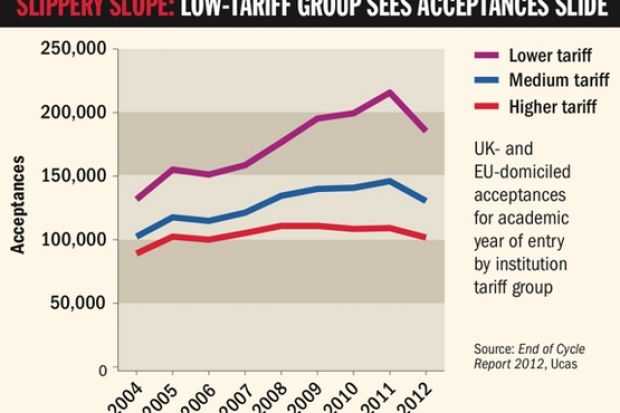That suggestion comes as the sector awaits details on how individual institutions have fared in the first year of £9,000 tuition fees.
The Universities and Colleges Admissions Service will this month publish figures, broken down by institution, for student numbers in 2012-13 and applications for 2013 entry. Viewed together, they could reveal whether a group of universities has a serious structural problem under the new system.
Sector-wide figures on 2013 entry published by Ucas last week showed that the number of applicants to university at 17 December 2012 was 5.6 per cent lower than at the same point in the cycle the previous year.
However, it is thought that unpublished Ucas figures at 30 December show a 2.2 per cent rise. There is still time for application figures to move further in either direction before the final Ucas deadline on 15 January.
Ucas’ end-of-cycle report on 2012 admissions suggests that some lower-tariff universities could be at risk of losing large numbers of students. Two successive years in which student numbers drop by 10 to 15 per cent could leave a university with severe financial problems.
The report shows that the number of students entering UK higher education fell by 54,000 (11 per cent) compared with 2011.
But a section of the report not covered by the media and not highlighted by Ucas at its press briefing shows the differing impact across different types of university.
It shows that the number of UK and European Union students accepting places in 2012 fell by 7,300 (-7 per cent) at institutions with high-entry tariffs, by 15,500 (-11 per cent) at medium-tariff institutions and by 30,500 (-14 per cent) at low-tariff institutions.
Meanwhile, an internal email at Canterbury Christ Church University seen by Times Higher Education reveals concern over the institution’s application figures for 2013.
Susan Piotrowski, pro vice-chancellor (academic), says in an email dated 5 December: “Nationally applications are currently down by 6.51 per cent.
“Disappointingly our applications are down 11.19 per cent, although at one stage in early November they were down 23 per cent.”
Professor Piotrowski also notes trends in the institution’s competitor group, made up of the universities of Brighton, Greenwich, Kent and Portsmouth and Anglia Ruskin and Kingston universities. She adds: “Our competitor institutions have also seen a decline in applications and they are currently down 10.69 per cent.”
Register to continue
Why register?
- Registration is free and only takes a moment
- Once registered, you can read 3 articles a month
- Sign up for our newsletter
Subscribe
Or subscribe for unlimited access to:
- Unlimited access to news, views, insights & reviews
- Digital editions
- Digital access to THE’s university and college rankings analysis
Already registered or a current subscriber? Login




